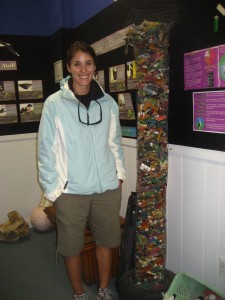Albatross as far as the eye can see! A lesson about invasive plant species and the local birds. Bike tour of our new home and its cultural, historical, and natural importance.
As we landed last night, the class was in awe at the sheer number of albatross scattered all over the ground. We could hear the chattering and high pitched whistles they make at each other when we took golf carts to the Charlie Barracks where we are staying.

We had a brief orientation to the island and quickly settled into our rooms before heading over to the Captain Brooks pub for some drinks, pizza, and games.
Bright (or should I say dark) and early the next morning we convened in the lobby before heading over for breakfast at the Clipper House. Then it was time for an orientation by Pete Leary, wildlife biologist with the US Fish and Wildlife Service (USFWS) about the local bird populations. Not only are there three species of albatross (laysan, black-footed, and short-tailed) but also the endangered Laysan duck. We saw all of these later in the day on our bike tour of the island. Pete explained to us the various threats to these birds, including ingestion of plastic. The albatross adults pick up marine debris and feed it to their chicks, subsequently causing some of them to die (be it directly or indirectly).

After that, we got to talk to Greg Shubert about invasive plant species on the island and the USFWS efforts to remove them and reintroduce native species. The invasive sunflower Verbesina leaves no room for the albatross chicks, sometimes causing them to become completely entangled in the weed.
Next it was time to pick out our bicycles for the rest of our stay, a very important decision. Though some were off to a wobbly start, we soon got a hang of the bikes and returned to the barracks. After a delicious lunch of vegetable curry, mussels, and fish, the class met with John Klavitter, the acting refuge manager with USFWS here on the island. What a great time we all had biking around the island and seeing our new surroundings. Mr. Klavitter’s job is extremely important because he basically oversees the entire well-being of the animals on and around Midway.

We saw albatross covering the ground almost outnumbering the vegetation! We also saw how many fill the sky during the day, which is why it is unsafe to fly in and out of the island during the day. John showed us the WWII memorials and the building where Lt George H. Cannon bravely sacrificed himself to protect his men and restore lost communication to the island during the first attack on Midway. We also discussed the difficult task of providing energy for the island and how the USFWS is doing what they can to reduce this cost.

The biggest lesson that everyone took away from today is that Midway, as well as the rest of the Northwestern Hawaiian Islands (NWHIs), is influenced by three things: culture, history, and nature. The Hawaiian culture is deeply rooted here in the NWHIs. The islands located north of the Tropic of Cancer are believed to be where Hawaiian souls go in the afterlife. This is a sacred place to native Hawaiians some of whom still travel here the way their ancestors did by utilizing the wind and sea. The battle of Midway occurred here during WWII and there are still remains of that conflict which remind us of the sacrifices made for our freedom. The first Medal of Honor in WW II was awarded to Lt Cannon of the USMC. There is still a lot of work to be done to protect and restore Midway, but it certainly boasts natural beauty and seascapes. As a Marine National Monument, National Wildlife Refuge, and National Memorial, the island and sea around it are strictly protected. More value is added to the area because it is also considered a UNESCO World Heritage site.

They are just everywhere, the albatrosses. I checked out the photos you posted of the birds and the their faces are amazing–I like those smoky eye shadows. Your posts are fun to read, and it’s good to see my daughter Leela’s face among you. I’m glad to know that these special islands and surrounding waters are being protected and that all of you are learning how to carry on this important environmental work. Hope the weather holds for you.